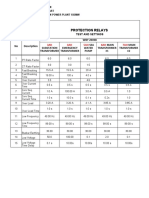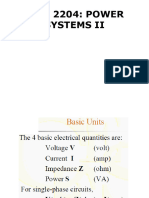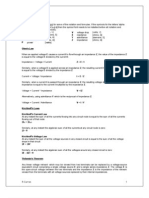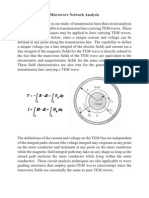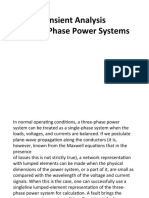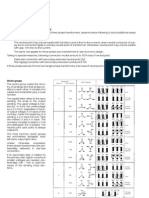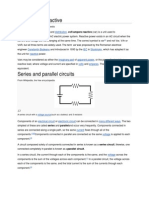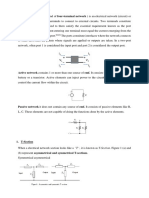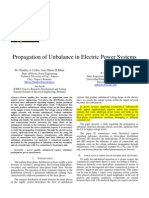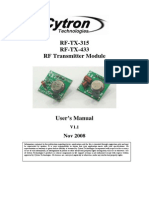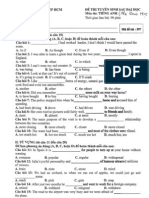0 ratings0% found this document useful (0 votes)
54 views04-Star Circuit V2
04-Star Circuit V2
Uploaded by
anhufriendIn a symmetrically loaded star circuit:
1) All phase voltages are identical and smaller than the line voltages by a factor of Ö3.
2) The voltage between the load's and generator's star points is zero, so that no current flows through the neutral conductor when it is connected.
3) When apportioning AC circuits to a three-phase system's individual phases, efforts should be made to balance the load to the greatest possible extent.
Copyright:
© All Rights Reserved
Available Formats
Download as PDF, TXT or read online from Scribd
04-Star Circuit V2
04-Star Circuit V2
Uploaded by
anhufriend0 ratings0% found this document useful (0 votes)
54 views2 pagesIn a symmetrically loaded star circuit:
1) All phase voltages are identical and smaller than the line voltages by a factor of Ö3.
2) The voltage between the load's and generator's star points is zero, so that no current flows through the neutral conductor when it is connected.
3) When apportioning AC circuits to a three-phase system's individual phases, efforts should be made to balance the load to the greatest possible extent.
Original Description:
04-Star Circuit V2
Copyright
© © All Rights Reserved
Available Formats
PDF, TXT or read online from Scribd
Share this document
Did you find this document useful?
Is this content inappropriate?
In a symmetrically loaded star circuit:
1) All phase voltages are identical and smaller than the line voltages by a factor of Ö3.
2) The voltage between the load's and generator's star points is zero, so that no current flows through the neutral conductor when it is connected.
3) When apportioning AC circuits to a three-phase system's individual phases, efforts should be made to balance the load to the greatest possible extent.
Copyright:
© All Rights Reserved
Available Formats
Download as PDF, TXT or read online from Scribd
Download as pdf or txt
0 ratings0% found this document useful (0 votes)
54 views2 pages04-Star Circuit V2
04-Star Circuit V2
Uploaded by
anhufriendIn a symmetrically loaded star circuit:
1) All phase voltages are identical and smaller than the line voltages by a factor of Ö3.
2) The voltage between the load's and generator's star points is zero, so that no current flows through the neutral conductor when it is connected.
3) When apportioning AC circuits to a three-phase system's individual phases, efforts should be made to balance the load to the greatest possible extent.
Copyright:
© All Rights Reserved
Available Formats
Download as PDF, TXT or read online from Scribd
Download as pdf or txt
You are on page 1of 2
Star circuit
Layout of a star circuit
Connecting the three ends of the load impedances Z
1
, Z
2
and Z
3
(i.e. U1, V1 and W1)
respectively to one of the outer conductors L1, L2 and L3, and the other ends to a common
terminal or star point as shown in the diagram below results in a star circuit (symbol: Y). The
neutral conductor can be connected to the star point as well.
In a star circuit, the current following through any of the phases (i.e. load resistances) is
equal to the current flowing through the corresponding outer conductor.
In a star circuit, the line currents are equal to the phase
currents.
Voltages and currents in the case of a symmetric (balanced) load
If all load impedances are equal, one speaks of a symmetric load. In this case, all phase
voltages are identical, and smaller than the line voltages by the concatenation factor.
In a symmetrically loaded star circuit, all phase voltages are
identical and smaller than the line voltages by a factor of 3.
The symmetry causes the phase voltages' instantaneous values to cancel each other out, so
that no voltage is present between the star point and neutral terminal. Therefore, if the
neutral conductor is connected, no current flows through it (I
N
= 0).
In a symmetrically loaded star circuit, the voltage between
the load's and generator's star points is zero, so that no
current flows through the neutral conductor when it is
connected I
N
.
Star circuit file:///C:/Program Files (x86)/LN/L@BSOFT/BooksENU/1A03/3PC/3p...
1 of 2 11/26/2013 10:55 AM
Voltages and currents in the case of an asymmetric (unbalanced) load.
In an asymmetrically loaded circuit, the phase voltages only become identical if the neutral
conductor is connected. Because the asymmetry prevents the phase currents' instantaneous
values from cancelling each other out here, a compensation current I
N
then flows through
the neutral conductor; its amperage depends on the degree of asymmetry. The more varied
the line currents are, the higher the current in the neutral conductor.
When apportioning AC circuits to a three-phase system's
individual phases (outer conductors), efforts should be made
to balance the load to the greatest possible extent.
If the neutral conductor is not connected, the star point is displaced, i.e. a voltage is present
between the load's star point and the neutral conductor. This results in excess or insufficient
voltages for the three-phase system's consumers. In this case, the concatenation factor of
3 no longer applies.
If different voltages occur across a three-phase system's
individual AC loads, this indicates that the neutral conductor
is either interrupted or not connected.
A symmetric star circuit with a line voltage of 400 V contains ohmic load resistors each
rated at 100 ohms. What is the value of the resultant phase currents? Enter the result in
the field provided below.
I = A
Star circuit file:///C:/Program Files (x86)/LN/L@BSOFT/BooksENU/1A03/3PC/3p...
2 of 2 11/26/2013 10:55 AM
You might also like
- Assessing The Impact of Urbanisation On Water Bodies Using GisDocument22 pagesAssessing The Impact of Urbanisation On Water Bodies Using GisCrispin Cris Nspm100% (1)
- 200 - 250 Kva Can-Model1Document1 page200 - 250 Kva Can-Model1Osanebi Chukwudi LuckyNo ratings yet
- All Relay SettingDocument10 pagesAll Relay SettingDangolNo ratings yet
- Star Connection Delta ConnectionDocument20 pagesStar Connection Delta Connectionjeswinch100% (1)
- Modul Praktikum Elda Satu Semester 5 FinalDocument29 pagesModul Praktikum Elda Satu Semester 5 FinalZdSentono ChannelNo ratings yet
- Lecture 2, Per Unit System, November 2022Document100 pagesLecture 2, Per Unit System, November 2022Igombe IsaacNo ratings yet
- IEEE Neutral+Conductor+CurrentDocument7 pagesIEEE Neutral+Conductor+CurrenttshiotshieNo ratings yet
- Capítulo 1 Basic Concepts - em - InglêsDocument49 pagesCapítulo 1 Basic Concepts - em - InglêsPaulinha BezerraNo ratings yet
- Astl CH1Document86 pagesAstl CH1fildzahsyafNo ratings yet
- Notation: R Curras 1Document27 pagesNotation: R Curras 1pauula123No ratings yet
- Harmonics in Three Phase Transformers: Delta ConnectionDocument24 pagesHarmonics in Three Phase Transformers: Delta Connectionshantanu kumar BaralNo ratings yet
- Microwave Network AnalysisDocument47 pagesMicrowave Network AnalysisbhushandabadeNo ratings yet
- Electrical Circuit TheoremsDocument5 pagesElectrical Circuit Theoremshitesh bhoiNo ratings yet
- Lecture 2: Three-Phase SystemDocument30 pagesLecture 2: Three-Phase SystemAddi KhattakNo ratings yet
- The Effects of Unbalanced Circuit in Power Losses and EfficienyDocument9 pagesThe Effects of Unbalanced Circuit in Power Losses and EfficienyInternational Journal of Innovative Science and Research TechnologyNo ratings yet
- Experiment No2Document3 pagesExperiment No2Efaz AfnanNo ratings yet
- Current Electricity (Edited)Document41 pagesCurrent Electricity (Edited)paperNo ratings yet
- TLW CH6Document49 pagesTLW CH6Raj MohanNo ratings yet
- Introduction To AC CircuitsDocument5 pagesIntroduction To AC CircuitsKeerthi Keerthana100% (1)
- Transient Analysis of Three-Phase Power SystemsDocument35 pagesTransient Analysis of Three-Phase Power SystemsBerly NoviantoniNo ratings yet
- Electrical Circuit TheoremDocument4 pagesElectrical Circuit TheoremS.M. WahiduzzamanNo ratings yet
- Stucor Ec8701 AmDocument607 pagesStucor Ec8701 AmPrakash DNo ratings yet
- Principal of Electrical and Electronics Communication EngineeringDocument36 pagesPrincipal of Electrical and Electronics Communication Engineeringguru934472No ratings yet
- PE351 Lect4 2020Document31 pagesPE351 Lect4 2020Abdul RazzaqNo ratings yet
- Lineas Trans1Document14 pagesLineas Trans1gajasamNo ratings yet
- Power Trans Vector GroupDocument1 pagePower Trans Vector GroupkhaifhalathNo ratings yet
- Electronics Linear Circuit CurrentDocument1 pageElectronics Linear Circuit CurrentMark Paul Santin GanzalinoNo ratings yet
- Characteristic Impedance: Driving An Infinite Transmission LineDocument7 pagesCharacteristic Impedance: Driving An Infinite Transmission LineSajeeth Ali100% (1)
- Three-Phase To Two-Phase/One-Phase Conversion Using TWO TRANSFORMERS (Scott Connection)Document13 pagesThree-Phase To Two-Phase/One-Phase Conversion Using TWO TRANSFORMERS (Scott Connection)Bhavani Chandra UniqueNo ratings yet
- Explain OC & SC Tests of A 1-Phase T/F.: Short Circuit Test On TransformerDocument10 pagesExplain OC & SC Tests of A 1-Phase T/F.: Short Circuit Test On Transformerarshadeee202No ratings yet
- 4three PhaseDocument9 pages4three Phasesuresh krishnanNo ratings yet
- Tsaadiquu PDFDocument31 pagesTsaadiquu PDFtadepeace23No ratings yet
- HV Substation Overvoltage Computation Taking Into Account Frequency Dependent Transients On The Substation Grounding SystemDocument6 pagesHV Substation Overvoltage Computation Taking Into Account Frequency Dependent Transients On The Substation Grounding Systemostojic007No ratings yet
- Volt-Ampere Reactive: Transmission Distribution Reactive PowerDocument15 pagesVolt-Ampere Reactive: Transmission Distribution Reactive PowerRose Janine BaliwagNo ratings yet
- Network FundamentalsDocument10 pagesNetwork FundamentalsRohitNo ratings yet
- Transmission LineDocument23 pagesTransmission LineVinod KumarNo ratings yet
- By Prof. Dr. R.K.DashDocument25 pagesBy Prof. Dr. R.K.Dashabdul jawadNo ratings yet
- WavesDocument5 pagesWavesskhushboo10No ratings yet
- So Urbano Yap - parallelWiringResistorsDocument4 pagesSo Urbano Yap - parallelWiringResistorsvada_soNo ratings yet
- TransformersDocument5 pagesTransformersMoawiah Al-HawajrehNo ratings yet
- Impedance Matching PDFDocument23 pagesImpedance Matching PDFkalavathiNo ratings yet
- 3544 FdocDocument8 pages3544 FdocDean SeepaneNo ratings yet
- Polarity Test TransformerDocument7 pagesPolarity Test TransformerPINEDA CRISTIAN PAUL C.No ratings yet
- Figure 1. Various Transmission LinesDocument12 pagesFigure 1. Various Transmission LineskpchakralaNo ratings yet
- Chapter Nine: Traveling Waves and Other Transients On Transmission LinesDocument4 pagesChapter Nine: Traveling Waves and Other Transients On Transmission LinesSafaaNo ratings yet
- Electricity and MagnetismDocument20 pagesElectricity and MagnetismMido YoussefNo ratings yet
- 519 - Transmission Line Theory by VishnuDocument24 pages519 - Transmission Line Theory by VishnuSairam SairamNo ratings yet
- 11.3-4 CURRENT ELECTRICITY my notes (Repaired)Document30 pages11.3-4 CURRENT ELECTRICITY my notes (Repaired)lotsithole6No ratings yet
- The Ideal TransformerDocument18 pagesThe Ideal TransformerlegendmahenNo ratings yet
- LLCalculationofVoltageUnbalanceFactorinPower07038370Document6 pagesLLCalculationofVoltageUnbalanceFactorinPower07038370bens082024No ratings yet
- Unit 5Document27 pagesUnit 5prashantpnd0780% (5)
- Lecture 1Document52 pagesLecture 1jaafarfh11No ratings yet
- Lab 5Document3 pagesLab 5Vincent LuiNo ratings yet
- Propogation of Unbalance in Electrical Power SystemsDocument5 pagesPropogation of Unbalance in Electrical Power SystemsNeethu EappanNo ratings yet
- Le - Ohms LawDocument13 pagesLe - Ohms LawMailee CañeteNo ratings yet
- Basic Elec Chapter 5Document19 pagesBasic Elec Chapter 5Nebiyou KorraNo ratings yet
- Lecture Power System RepresentationDocument8 pagesLecture Power System RepresentationRaniel Rey CantorNo ratings yet
- EXPT4Document5 pagesEXPT4jivankharat30No ratings yet
- Eca Notes - Final Ver - 22.07.2023 (For Print)Document247 pagesEca Notes - Final Ver - 22.07.2023 (For Print)prem sunderNo ratings yet
- A MATLAB Based Cellular Mobile Communication LaboratoryDocument12 pagesA MATLAB Based Cellular Mobile Communication LaboratoryBenedict LumabiNo ratings yet
- MPT ManualDocument7 pagesMPT ManualanhufriendNo ratings yet
- Metrology Lab - IntroductionDocument1 pageMetrology Lab - IntroductionanhufriendNo ratings yet
- EEIT Communication Lab COM3Lab 70073-Digital Communication TechnologyDocument3 pagesEEIT Communication Lab COM3Lab 70073-Digital Communication TechnologyanhufriendNo ratings yet
- NAO - Return Material AuthorizationDocument1 pageNAO - Return Material AuthorizationanhufriendNo ratings yet
- RF TX User's ManualDocument8 pagesRF TX User's ManualanhufriendNo ratings yet
- EEIT2012 Experiment 2 Free FallDocument3 pagesEEIT2012 Experiment 2 Free FallanhufriendNo ratings yet
- De Thi CH TA 2008Document7 pagesDe Thi CH TA 2008Nghi PhamNo ratings yet
- So4203 2aDocument17 pagesSo4203 2aanhufriendNo ratings yet
- Town of West Seneca - v. - Nussbaumer & Clarke, Inc.Document33 pagesTown of West Seneca - v. - Nussbaumer & Clarke, Inc.Daniel T. Warren100% (1)
- Nellcor N-20 Pulse Oximeter - Service ManualDocument82 pagesNellcor N-20 Pulse Oximeter - Service ManualdajichNo ratings yet
- D LL State MachineDocument51 pagesD LL State MachinepoiopipoNo ratings yet
- 5.2.3.7 Lab - Configuring Port Address Translation (PAT)Document6 pages5.2.3.7 Lab - Configuring Port Address Translation (PAT)robinNo ratings yet
- Johny's Oracle Tips - OAF - The Program Can't Start Because MSVCR71.Dll Is Missing From Your ComputerDocument1 pageJohny's Oracle Tips - OAF - The Program Can't Start Because MSVCR71.Dll Is Missing From Your ComputerOne dayNo ratings yet
- Fire and Arson Investigation ReviewerDocument17 pagesFire and Arson Investigation ReviewerJohn Paul TanNo ratings yet
- Workbook Unit 10Document12 pagesWorkbook Unit 10RoqueNo ratings yet
- SGS 17025 Cert & ScopeDocument251 pagesSGS 17025 Cert & ScopeomerNo ratings yet
- MEP Project Manager - Marwan CDocument2 pagesMEP Project Manager - Marwan CmarwanNo ratings yet
- Simulation Exercise On Waste Management (National School of Public Policy)Document22 pagesSimulation Exercise On Waste Management (National School of Public Policy)Salman Choudhry100% (1)
- LNCT Univercity, Bhopal (M.P) : Linux and ExcelDocument8 pagesLNCT Univercity, Bhopal (M.P) : Linux and ExcelanshuNo ratings yet
- Randolph 1981Document13 pagesRandolph 1981SaeedNo ratings yet
- Benevectoras ResubmissionDocument46 pagesBenevectoras ResubmissionNeil Basu100% (1)
- Defrost SystemsDocument94 pagesDefrost Systemsorgasmosaurio9808100% (7)
- Lista de FiltrosDocument155 pagesLista de FiltrosGonçalo Filipe SousaNo ratings yet
- Hafele India MRP Version Price List - July 15,2021Document544 pagesHafele India MRP Version Price List - July 15,2021Kiran HaridasNo ratings yet
- Spesifikasi Multix Impact C (High Throughput)Document1 pageSpesifikasi Multix Impact C (High Throughput)Radiologi RSUD KilisuciNo ratings yet
- Split Valuation NotesDocument3 pagesSplit Valuation Notesbeema1977No ratings yet
- Internship Report: Elmetec Private Limited LahoreDocument32 pagesInternship Report: Elmetec Private Limited LahoreJimmyThackerNo ratings yet
- Hydraulic Design and Experimental Investigation of Roof Drainage SystemDocument12 pagesHydraulic Design and Experimental Investigation of Roof Drainage SystemaishNo ratings yet
- Sop For PWG SystemDocument6 pagesSop For PWG SystemShyam QCNo ratings yet
- The Search For Innovative Fragrant Molecules: B 2008 Verlag Helvetica Chimica Acta Ag, ZdrichDocument16 pagesThe Search For Innovative Fragrant Molecules: B 2008 Verlag Helvetica Chimica Acta Ag, ZdrichOctavian CoifanNo ratings yet
- Socla 895Document4 pagesSocla 895Miguel-Angel RuizNo ratings yet
- Catalogo IV GoldDocument232 pagesCatalogo IV GoldEurico José CuinicaNo ratings yet
- Section 11 - Project Management System - MDocument9 pagesSection 11 - Project Management System - MarunghandwalNo ratings yet
- Stand Cons T DetailsDocument164 pagesStand Cons T DetailsmirfanjpcgmailcomNo ratings yet


